Post-operative Care – Knee
The following are some ways to incorporate movement after you have had knee replacement surgery. Discuss these techniques with your physicians and orthopedist before attempting them. Your therapist may modify some of these techniques depending upon your situation (i.e., age, weight, and procedure). Only do the techniques that are recommended by your physician and/or therapist.
Lying Down
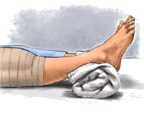 To help promote flexibility in your knee while lying down, place a rolled-up bath towel under your ankle. As your knee straightens, you may feel a gentle stretch in your thigh area.
To help promote flexibility in your knee while lying down, place a rolled-up bath towel under your ankle. As your knee straightens, you may feel a gentle stretch in your thigh area.
Sitting Up
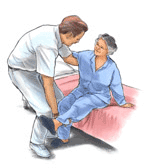 For the first few times, your physician or therapist may move and hold your leg. Soon you will sit at the edge of the bed with your foot resting on a small stool without assistance. You may be asked to stretch your operated leg and rest it on a chair.
For the first few times, your physician or therapist may move and hold your leg. Soon you will sit at the edge of the bed with your foot resting on a small stool without assistance. You may be asked to stretch your operated leg and rest it on a chair.
Standing With Support
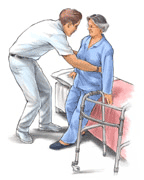 For a while, your physician or therapist may help you stand. A safety belt may be placed around your waist to support you just in case you feel dizzy. A splint may also be placed around your operated leg to keep it from moving and protect your knee as you stand.
For a while, your physician or therapist may help you stand. A safety belt may be placed around your waist to support you just in case you feel dizzy. A splint may also be placed around your operated leg to keep it from moving and protect your knee as you stand.
Using a Walker
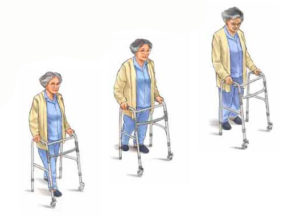 Once you can stand, you will probably use a walker to help you keep your balance. Initially, you will be told to place only a small amount of weight on your operated leg as you walk. As your knee becomes stronger, your doctor will tell you when you can increase the amount of weight placed on your operated leg.
Once you can stand, you will probably use a walker to help you keep your balance. Initially, you will be told to place only a small amount of weight on your operated leg as you walk. As your knee becomes stronger, your doctor will tell you when you can increase the amount of weight placed on your operated leg.
Step 1 – With both hands lift and scoot the walker and place it a few inches in front of you. Be certain all four legs of the walker are down before proceeding.
Step 2 – Lean on the walker and let it help support your weight. Step forward and through the walker with your operated leg. Be careful not to wrap your leg around the legs of the walker.
Step 3 – Hold on to the walker firmly with both hands, then step forward placing your unoperated leg through the walker.
Walking with Crutches
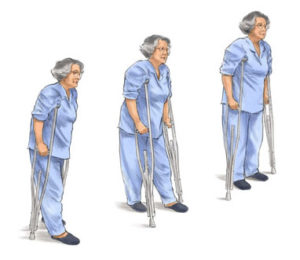 Once your knee and leg muscles are strong enough, your physician or physical therapist may recommend crutches instead of using a walker. Your therapist will give you guidelines on how far and how long you may walk.
Once your knee and leg muscles are strong enough, your physician or physical therapist may recommend crutches instead of using a walker. Your therapist will give you guidelines on how far and how long you may walk.
Step 1 – With the crutches firmly in place, place pressure on your hands, not on your armpits.
Step 2 – Move the operated leg and both crutches forward at the same time.
Step 3 – Looking up and straight ahead, first step through the crutches with the operated leg followed by your unoperated leg.
Walking Up Stairs with Crutches
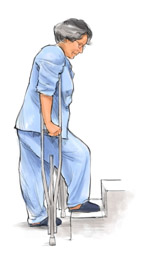 With your crutches upright on the floor and firmly planted for support, lift your unoperated leg and place it on the step. Leaning forward on the crutches, lift yourself up. Use the crutches and your unoperated leg to support your weight. Now lift your operated leg up onto the step. You may want to have someone help you the first few times until you become comfortable with stairs.
With your crutches upright on the floor and firmly planted for support, lift your unoperated leg and place it on the step. Leaning forward on the crutches, lift yourself up. Use the crutches and your unoperated leg to support your weight. Now lift your operated leg up onto the step. You may want to have someone help you the first few times until you become comfortable with stairs.
Walking Down Stairs with Crutches
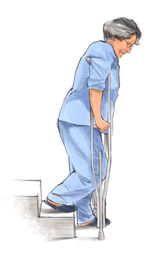 Place your crutches and your operated leg on the lower step. Use the crutches for balance and lower yourself carefully down onto the step moving the crutches as you move the operated leg. Again, you may wish to have someone assist you the first few times you try this.
Place your crutches and your operated leg on the lower step. Use the crutches for balance and lower yourself carefully down onto the step moving the crutches as you move the operated leg. Again, you may wish to have someone assist you the first few times you try this.
Once You Are at Home
It is very important that you follow your surgeon’s instructions. The following suggestions should be discussed with your surgeon before your hospital discharge:
- If you will be using a walker or crutches to assist with walking, ask your doctor how much weight you may put on your operated leg.
- Remember that you will probably tire more easily than usual. You may want to plan a rest period of 30 to 60 minutes mid-morning and mid-afternoon.
- It is safer and easier to get in and out of chairs using both arms and you should avoid low or overstuffed furniture. To increase your comfort, use a cushion or pillow to raise your body while seated.
- An elevated toilet seat may reduce stress to your hips and knees as you sit and stand.
- A shelf placed in the shower at chest height may reduce having to bend to retrieve items while in the shower.
- A bathtub seat (bench) allows you to sit while bathing for increased safety and comfort.
- A long-handled bath sponge may be used to reach lower legs. Women can also purchase razor extenders to shave their legs.
- Avoid sweeping, mopping, and running the vacuum cleaner. Use long-handled feather dusters for dusting high and low items. Your doctor will tell you when it is okay to sweep, mop, and vacuum.
- You may ride in a car, but you must follow your doctor’s instructions for how to get in and out of the vehicle. You can raise the height of the car seat with pillows to protect your hips and knees as well. Your doctor will talk with you about when you can drive, typically within four to six weeks after surgery. If you have a car with manual transmission, talk with your doctor about driving limitations. Make sure you can brake the car without discomfort before you attempt to drive in traffic.
- Constipation is a common problem for patients following surgery. This is usually due to your limited activity and any pain medications you may be taking. Discuss your diet with your doctor. It should include fresh fruits and vegetables as well as eight full glasses of liquid each day, unless your doctor tells you otherwise.
- Your doctor will probably give you a prescription for pain pills. Please follow your doctor’s instructions concerning these medications.
- Some swelling around the incision is normal. You will find it more comfortable to wear loose clothing to avoid pressure on the incision. Ask your doctor or other qualified health professional about appropriate wound care.
